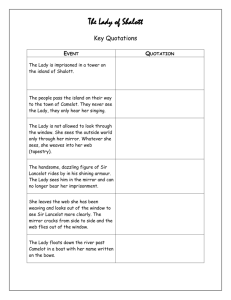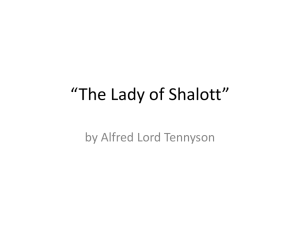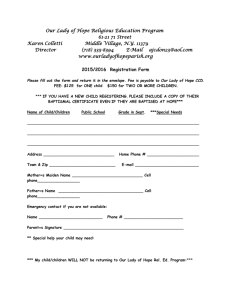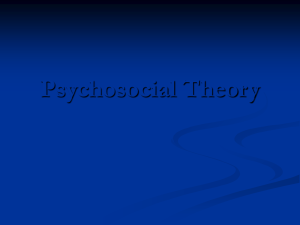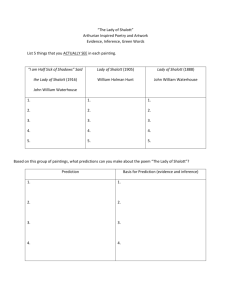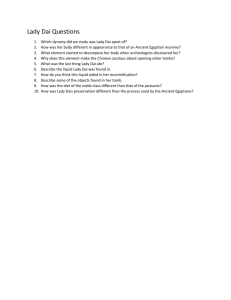W.H.Hunt : The Lady of Shalott
advertisement
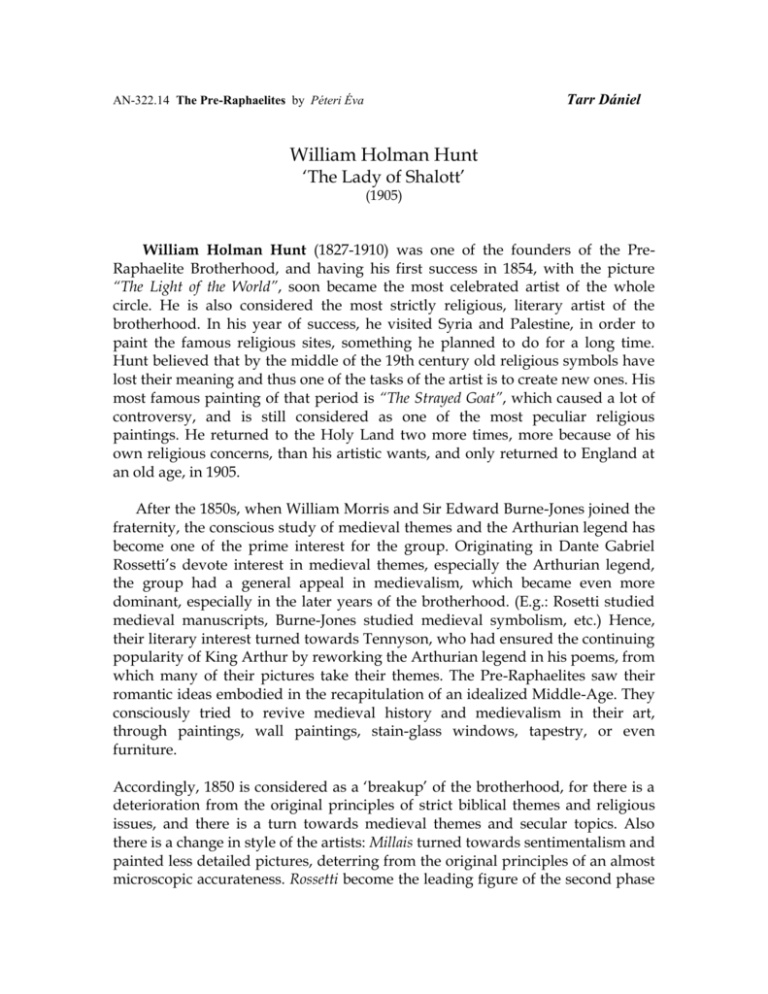
Tarr Dániel AN-322.14 The Pre-Raphaelites by Péteri Éva William Holman Hunt ‘The Lady of Shalott’ (1905) William Holman Hunt (1827-1910) was one of the founders of the PreRaphaelite Brotherhood, and having his first success in 1854, with the picture “The Light of the World”, soon became the most celebrated artist of the whole circle. He is also considered the most strictly religious, literary artist of the brotherhood. In his year of success, he visited Syria and Palestine, in order to paint the famous religious sites, something he planned to do for a long time. Hunt believed that by the middle of the 19th century old religious symbols have lost their meaning and thus one of the tasks of the artist is to create new ones. His most famous painting of that period is “The Strayed Goat”, which caused a lot of controversy, and is still considered as one of the most peculiar religious paintings. He returned to the Holy Land two more times, more because of his own religious concerns, than his artistic wants, and only returned to England at an old age, in 1905. After the 1850s, when William Morris and Sir Edward Burne-Jones joined the fraternity, the conscious study of medieval themes and the Arthurian legend has become one of the prime interest for the group. Originating in Dante Gabriel Rossetti’s devote interest in medieval themes, especially the Arthurian legend, the group had a general appeal in medievalism, which became even more dominant, especially in the later years of the brotherhood. (E.g.: Rosetti studied medieval manuscripts, Burne-Jones studied medieval symbolism, etc.) Hence, their literary interest turned towards Tennyson, who had ensured the continuing popularity of King Arthur by reworking the Arthurian legend in his poems, from which many of their pictures take their themes. The Pre-Raphaelites saw their romantic ideas embodied in the recapitulation of an idealized Middle-Age. They consciously tried to revive medieval history and medievalism in their art, through paintings, wall paintings, stain-glass windows, tapestry, or even furniture. Accordingly, 1850 is considered as a ‘breakup’ of the brotherhood, for there is a deterioration from the original principles of strict biblical themes and religious issues, and there is a turn towards medieval themes and secular topics. Also there is a change in style of the artists: Millais turned towards sentimentalism and painted less detailed pictures, deterring from the original principles of an almost microscopic accurateness. Rossetti become the leading figure of the second phase of the movement, with his new concepts of subjectivity, importance of beauty, and “stopping time” - the apprehension of the expressions of moods and feelings of a precise moment. He also started using water colours instead of oil paints, using them to increase decorativity and ways to express dimensional means, which gave a completely different atmosphere to his new pictures. Hunt is considered the one, who mostly stuck to the original ideas; painting open-air, after a model, and also with highly detailed accuracy. His pictures kept the concept of relating to a literary topic too, thus carrying a moral and symbolic meaning. Hunt’s painting, The Lady of Shalott, painted at the end of his life, - at the age of 87 - in 1905, is a good example of the late pre-Raphaelite concepts. It reflects the early notions of the brotherhood as well as the later ones, creating a kind of synthesis of the early religious issues and the late medieval, Arthurian themes. It also creates a synthesis of the early and later concepts of representation, thus the stillness of a landscape and the seizure of a dynamic moment. Hunt made a large and small version of the same picture, both of which were not completed until 1905, which differ in some of their symbolism. I will occasionally make comparison between the two versions, which I shall name large version and small version correspondingly. Tennyson created the figure of the Lady of Shalott by reworking in his poems the Arthurian legend. Confined to a tower, the lady is forbidden to look at the actual world except in the reflection of a mirror. One day however, Sir Lancelot rides past, singing heedlessly to himself, and the lady is so captivated by his appearance, that she leaves her loom and looks out of the window to see him, thus bringing the curse of death upon herself. For Tennyson the poem was a romance, the moral of which was, if anything vague. But in the hand of Holman Hunt it became a sermon on the “sinfulness of dereliction of duty”, as he described it, and illustrated “the failure of a human soul towards its accepted responsibility”1. Hunt chose to represent the dramatic moment when the spell under which the lady lives is broken. Out flew the web and floated wide The mirror crack’d from side to side; “The curse is come upon me”, cried The Lady of Shalott. Hunt combined his classic, highly detailed Pre-Raphaelite technique with an extraordinarily elaborate iconography, which is expressed through the symbolic objects and decorations that fill the room. Understanding their symbolism shall be our task. 1 See: Spalding - Magnificent Dreams . p.72. The picture can be divided into three well distinguished parts: In the foreground is the Lady of Shalott herself, entangled in cords of her own embroidery coming apart. Surrounding her are a number of symbolic objects that will foretell her doom. In the middle is the wall of the room, which is richly decorated with tapestry depicting scenes of religious issues - the only major thing that differs in the two versions of the picture. The background consists of the landscape and Sir Lancelot’s riding figure reflected in the mirror. The dark colour of the tapestry gives a generally gloomy atmosphere to the picture, only to be contradicted by the very bright landscape in the mirror and the reflecting light on the Lady’s pink dress. The figure of the Lady of Shalott is a typical pre-Raphaelite beauty: She has remarkably long, light-brown hair, that flies loose in the room covering much of the tapestry behind her. She is elegant, but dressed very simply; a white skirt and a pink gown on top with an embroidered golden vest. Also she has no jewelry, and is barefoot - a clear representation of natural beauty, something so much emphasized in Rosetti’s “Hand and Soul” or Morris’s “News from Nowhere”. The background landscape is of a great wheat-field and a following river, with clear sunshine and a bright-blue sky - completely in opposition to the dark, gloomy tapestry that dominates the room. Lancelot rides forth in shiny armor with two musicians ahead of him catching the interest of the Lady of Shalott. Although the landscape is not so much detailed as it is usually prescribed by the pre-Raphaelite ideas, even more, it is a little unclear due to the reflection in the mirror, it still has its prescribed importance of representing harmony and freedom - Lancelot riding away into the sunlit world. The dark tapestry does not resemble Morris’s designs, and is neither a medieval style, but more like a renaissance gobelin, depicting scenes of inconsequential topics with no specific symbolism on the small version, but on the contrary, significant scenes of great symbolic value from the Bible on the large version. On the small version there are baby-like angel figures playing music and holding tools in the top two images, while there is a sitting, king like figure with a blue sphere in his hand in the right picture, and a kneeling figure looking up the sky in the left picture. These are all more of a Protestant theme, with little, if any, relevance to the picture as a whole. The scenes on the large version however, all use tractarian symbolism, much typical of Hunt’s earlier works. The top left image portrays angels holding (or creating even) planets, similarly to the top right one, where there are also angels holding the seven planets - the angel holding earth treading on a dragon. Also there is an interesting image on the top left part of this picture: a light sphere surrounded by a spiral of souls, veering towards this source. Thus the picture possibly indicates the determinative aspect of human life, with forces greater than men setting course to individual life. Similarly the Lady of Shalott is forbidden to look at the world directly, which is her accepted responsibility. The right picture represents Adam taking an apple from the tree of life - he is about to commit the original sin, condemning himself and humankind forever. He holds a lionskin in his hand which symbolizes power; and there are sleeping female musicians in the background at the trunk of the tree symbolizing sleeping conscience. There is an overwhelming antagonism of slumbering moral strength and the power of the seductive act. Similarly the Lady of Shalott is faced with a similar situation, where her awareness is weakened by the sight of Lancelot and she falls to her doom by looking at him real life. The left picture shows the baby Christ with Joseph and Mary in the stable with angels looking down - the symbol of salvation and birth. Sin and salvation are opposed in the two scenes, left and right. Similarly the Lady of Shalott is yet now bound by death, - the cords of her work entangle her mercilessly - she is free to leave her room and go to find the one she loves, the one who she sacrificed her eternal life for. The romantic love story is also conferred through various symbols: There are two pairs of white doves flying together, circling the room and gliding by the window above the mirror together to be free. (Although there is only one dove leaving the room in the small version.) There are two flowers, red and white, placed at the two sides of the mirror (which are united in the large version - red and white flower put together in both vases). Similarly the Lady of Shalott fell in love with Lancelot upon having set eyes upon him - she lost her eternal life because of love. However, there love story is not a happy one, for it is the tale about the cause of loss. As all Arthurian legends, this one too is about the finding of the totality of oneself - finding the Grail. The story, paralleling the tale about the love of Lancelot and Guinevere, also ends in divestiture. The Lady of Shalott looses her infinite life and thus loses the totality of herself. The center embroidery, which depicted a knight finding the Grail in the gardens of Heaven, becomes disengaged, and the cords flying free, enmesh the Lady in the physical world she is ordained to earthly conditions. For Hunt it is truly the failure of a human soul towards its accepted goal. Being entrapped in the physical world - becoming an earthbound creature is symbolized by the cords binding her while she is standing in the circle of her embroidery, which is surrounded by a thick brass parapet. The parapet is supported by pillars that are of different shape, each bearing different symbols symbolizing one of the four elements of the physical world apiece. (This is completely missing in the small version.) Correspondingly: The left column has waves at its foot, reeds on its side and a shell on the top - this is water. The middle column has leaves at its foot, smooth spiral surface on the side, and a globe on the top - this is earth. The right column has a sun at its foot, cloud like formations on its side and on the top - this is air. The fourth element is not illustrated, probably because of technical reasons; having four pillars in such a short space would have made it look too crowded. This quaternity of the physical world however, is also represented by that obscure table, which stands next to the embroidery, with a sphinx figure as the base and four birds on the top. (The small version also has four candles.) The sphinx was always considered the guardian of the human world and also the knower of all secrets, while the four birds (an owl and eagle can be seen on the small version) correspond to the four directions and four general principles that govern the sphere of the Earth. This metaphysical complexity of the situation, - the question of gaining or loosing the totality of oneself - is also depicted and broadened by the rich decoration on the floor, placed around the three pillars of water, earth and air. Although these drawings relate to these principles separately, carrying a meaning on their own; they are also linked with each other with a threefold streak and constitute a whole, symbolizing the three levels of existence: the underworld, the earth, and heaven. Accordingly there is the Leviathan serpent of the underworld twisting around the pillar of the underworld - water. There are humans and animals around the pillar of Earth - earth, while there are tools and instruments around the pillar of Heaven - air. These also correspond to the psyche or spirit (water), the body (earth), and mind (air) of men; signifying the complexity of all deeds of men. This symbolism widens the range of interpretation and extends the enigma far beyond the limit of an earthly subject and makes it a universal predicament. Likewise, the adverse outcome, the fall of the Lady of Shalott is also foretold by the decoration on the floor of the room: There are heads of the Hydra assigned to the Underworld and Earth drawing as well as a skull. The Hydra was a mythical being who was not to be looked at, for when one did the look of the Hydra immediately turned him into stone. The skull on the other hand is the symbol of death. Similarly the Lady of Shalott was not to look at the world, for when she did she would bring death on herself. Also the drawing ascribed to earth, depicts a scene of a fight between the lion and the bull. This ancient symbol describes the constant dual between two basic human capacities: the bull is the symbol of emotions, sensuality and passion, while the lion is the symbol of reason and will. These two sides of men always battle against each other, usually ending in disaster - the bull and the lion killing each other - preventing men from reaching his ultimate goal; reaching the totality of oneself. Moreover, there are also two angel wings on the floor, one open and one closed, symbolizing the two possibilities of freedom and constrainedness, indicating the possible twofold consequence of her decision - of every human decision. However, one more symbol is added to the picture, missing from the small version, signifying the failure of the Lady of Shalott - the failure of the human soul to reach its final goal. There are parched blue lilies lying on the floor, symbolizing the downfall and oncoming death of the Lady of Shalott. Thus is the negative outcome of every human life; finding death instead of eternal life, depicted in this complex symbolism. Hence, The Lady of Shalott is a good example of Hunt’s late concepts. It reflects the early pre-Raphaelite notions of the brotherhood as well as the later ideas of Hunt. He uses a literary subject as well as uses rich symbolism, both typical features of the early concepts. He returns to tractarian symbolism in the scenes of the tapestry, while he uses mythological symbolism in the drawings of the floor. He also uses the Arthurian legend as the basis of his exposition, meanwhile imposing his own religious ideas of human condemnation upon it. Consequently he creates a kind of synthesis of the early religious issues and the late medieval, Arthurian themes of the pre-Raphaelite brotherhood. Also, while keeping much to the style of his earlier works, he also creates a synthesis of the early and later concepts of representation; thusly the stillness of the landscape and tranquillity of the interior surroundings opposed to the seizure of a highly emotional, dynamic moment. Pictures taken from: A) “The Lady of Shalott” (1905) [large version] p.74. in Spalding, Frances : Magnificent Dreams - Burne-Jones and the late Victorians . [Phaidon, 1978 Oxford]. B) “The Lady of Shalott” [small version] p.22. in Malory, Sir Thomas : Tales of King Arthur . [Book Club Associates, 1980 London].
